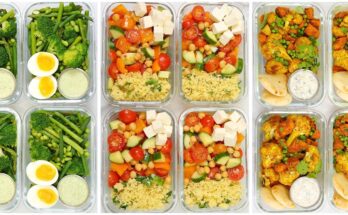Korean Tteokbokki Recipe: If you’ve ever strolled through the bustling streets of Seoul, you’ve probably been tempted by the irresistible aroma of spicy, savory, and slightly sweet rice cakes simmering in a rich red sauce. That, my friend, is tteokbokki (떡볶이)—Korea’s ultimate comfort food. Whether enjoyed as a quick street snack from a pojangmacha (street stall) or cooked at home with family, tteokbokki is a dish that brings people together.
This step-by-step guide will walk you through everything you need to know: the essential ingredients, preparation techniques, and the exact cooking process. By the end, you’ll be able to whip up your own authentic Korean tteokbokki at home, bursting with flavor and spice.
What is Tteokbokki?
Tteokbokki is a classic Korean dish made with chewy rice cakes (tteok) simmered in a vibrant red sauce, primarily flavored with gochujang (Korean chili paste). Traditionally, it was a royal court dish prepared with soy sauce instead of chili, but the modern spicy version took over during the mid-20th century. Today, it’s one of the most beloved Korean foods both in Korea and internationally.
The magic of tteokbokki lies in its perfect balance of textures and flavors. The rice cakes are soft yet chewy, the sauce is spicy yet slightly sweet, and additional ingredients like fish cakes, boiled eggs, and vegetables add depth. It’s a dish that satisfies both your taste buds and your cravings for something hearty and comforting.
Why Tteokbokki is Popular in Korea and Worldwide
In Korea, tteokbokki isn’t just food—it’s a cultural experience. It’s often eaten as a quick snack after school, shared with friends at street stalls, or enjoyed late at night with drinks. Its affordability, accessibility, and bold flavor make it a staple for people of all ages.
Internationally, the popularity of Korean dramas and K-pop has introduced global audiences to Korean cuisine. Scenes of characters devouring steaming plates of tteokbokki have sparked curiosity and cravings among viewers worldwide. Food enthusiasts love tteokbokki because it’s customizable—you can make it mild or fiery, add cheese for creaminess, or toss in instant noodles for extra indulgence.
Ingredients You’ll Need
Before we dive into the cooking process, let’s gather the essential ingredients. Tteokbokki may look fancy, but most of the ingredients are simple and easy to find at Asian grocery stores.
Essential Ingredients for Authentic Tteokbokki
To make classic tteokbokki, you’ll need:
- Tteok (Korean rice cakes) – Long, cylinder-shaped rice cakes are the heart of this dish. Fresh ones are best, but frozen works too if soaked beforehand.
- Eomuk (fish cakes) – Adds a savory, slightly chewy texture that complements the rice cakes.
- Gochujang (Korean chili paste) – Provides the iconic deep red color and spicy kick.
- Gochugaru (Korean chili flakes) – Enhances the spice and smoky flavor.
- Soy sauce – Balances the spiciness with umami depth.
- Sugar (or corn syrup) – Gives the dish its signature sweet-and-spicy taste.
- Garlic – For an aromatic punch.
- Water or anchovy broth – The base liquid that carries the sauce.
Optional Ingredients to Enhance Flavor
While the above are the essentials, you can add extras to suit your taste:
- Hard-boiled eggs – A classic add-on that soaks up the sauce beautifully.
- Green onions – For freshness and crunch.
- Cabbage or carrots – Adds sweetness and texture.
- Sesame seeds and sesame oil – For nutty aroma and garnish.
Substitutes for Hard-to-Find Ingredients
If you don’t have access to certain Korean ingredients, here are some swaps:
- Instead of fish cakes, try tofu puffs or fried tofu slices.
- If gochugaru isn’t available, use crushed red pepper flakes (though flavor may slightly differ).
- For anchovy broth, you can substitute with vegetable or chicken stock.
- If you can’t find tteok, use thick rice noodles or gnocchi as a creative replacement.
The flexibility of tteokbokki means you can adapt it to what’s available while still enjoying the essence of the dish.
Preparing the Ingredients
Before cooking, it’s crucial to prepare each component properly. A little effort here ensures that your tteokbokki turns out flavorful and authentic.
How to Prepare Rice Cakes (Tteok) Properly
Fresh rice cakes can be cooked right away, but frozen ones need soaking. Place frozen tteok in warm water for about 10–15 minutes until they soften. This prevents them from cracking during cooking and helps them absorb sauce better.
Prepping Vegetables and Add-ons
- Slice fish cakes into bite-sized pieces.
- Chop cabbage, carrots, and green onions into medium strips.
- Peel and slice boiled eggs if you want them halved.
Having everything prepped and ready makes the cooking process smooth and stress-free.
Tips for Balancing Sweetness, Spiciness, and Umami
Tteokbokki sauce should be a harmony of flavors—spicy, sweet, and savory. Adjust sugar, gochujang, and soy sauce levels depending on your taste preference. If you want it milder, reduce chili flakes or add a little more sugar. For richer depth, use anchovy broth instead of plain water.
Step-by-Step Guide to Cooking Tteokbokki
Now comes the fun part—cooking! Follow this step-by-step process to achieve the perfect bowl of tteokbokki.
Step 1 – Soaking and Preparing the Rice Cakes
If using frozen rice cakes, soak them until soft. This ensures they cook evenly and become pleasantly chewy instead of tough. Drain them well before adding to the pot.
Step 2 – Making the Flavorful Broth
In a large pan, bring 3–4 cups of water or anchovy broth to a boil. This liquid will form the base of the sauce, so don’t skip this step. Anchovy broth especially elevates the flavor with subtle umami.
Step 3 – Adding the Gochujang Sauce
Mix gochujang, soy sauce, sugar, garlic, and gochugaru together in a small bowl, then add it to the simmering broth. Stir well to create a smooth, spicy sauce. Taste it at this stage and adjust seasoning as needed.
Step 4 – Cooking Rice Cakes Until Tender
Add the softened rice cakes and let them simmer in the sauce for 10–15 minutes, stirring occasionally. The rice cakes should become soft, chewy, and coated in a thick, glossy sauce.
Step 5 – Final Touches and Garnishing
Once the rice cakes are cooked, add in fish cakes, vegetables, and boiled eggs. Let them simmer for a few more minutes until everything is coated in sauce. Finally, sprinkle with sesame seeds and green onions for garnish.
And just like that, your homemade Korean tteokbokki is ready to serve!
Serving and Enjoying Tteokbokki
Best Side Dishes to Pair with Tteokbokki
Tteokbokki is already flavorful on its own, but pairing it with the right side dishes can elevate your meal to a full Korean dining experience. In Korea, it’s often enjoyed with odeng-guk (fish cake soup), which balances out the spiciness of the rice cakes. Another popular pairing is kimchi, the iconic Korean fermented cabbage that adds a tangy and refreshing contrast.
Street stalls often serve tteokbokki with twigim (Korean-style tempura)—deep-fried vegetables, dumplings, or seaweed rolls. The crunchy, savory bites dipped in the spicy tteokbokki sauce create a heavenly combo. You might also enjoy it with gimbap, a Korean seaweed rice roll, which offers a mild and filling complement.
If you’re hosting at home, consider adding steamed dumplings, pickled radish, or even fried chicken to the table. These dishes balance the bold flavors of tteokbokki, making the meal more exciting and satisfying.
How to Store and Reheat Leftover Tteokbokki
Tteokbokki is best enjoyed fresh, but sometimes you’ll have leftovers. The challenge is that rice cakes tend to harden as they cool. To store them properly, transfer the cooled dish into an airtight container and refrigerate. It will keep for up to 2 days.
When reheating, add a splash of water or broth to loosen up the sauce and bring back the soft texture of the rice cakes. Heat it gently over the stove or microwave until warm. Avoid overheating, as it can make the rice cakes tough.
If you know you’ll have leftovers, another trick is to cook the rice cakes slightly less the first time, so they don’t become too mushy when reheated.
Creative Variations (Cheese Tteokbokki, Ramen Tteokbokki, Seafood Tteokbokki)
One of the reasons tteokbokki is beloved worldwide is its versatility. You can easily tweak the recipe to suit your taste or mood:
- Cheese Tteokbokki – Add mozzarella or cheddar cheese on top while the dish is still hot. The melted cheese creates a creamy, stretchy texture that balances the spice.
- Rabokki (Ramen Tteokbokki) – Toss in a pack of instant ramen noodles during cooking. This creates a more filling and indulgent meal, perfect for carb lovers.
- Seafood Tteokbokki – Add shrimp, squid, or mussels to bring a briny, ocean-like depth to the sauce.
- Cream Tteokbokki – Use cream or milk to mellow down the spiciness and give the sauce a silky texture.
- Jjajang Tteokbokki – Swap out the spicy sauce for jjajang (black bean paste) for a savory, slightly sweet alternative.
These creative variations allow you to experiment while still keeping the heart of the dish—the chewy rice cakes—intact.
Health Benefits and Nutritional Value
Nutritional Breakdown of Tteokbokki
Tteokbokki is undeniably delicious, but many wonder about its nutritional value. A typical serving (about 1 cup) contains:
- Calories: 300–400 (depending on add-ons)
- Carbohydrates: High, since rice cakes are primarily made from rice flour
- Protein: Moderate, especially if fish cakes, eggs, or seafood are added
- Fat: Varies, but can increase if cheese or fried items are included
- Sodium: High due to gochujang and soy sauce
While not a “diet food,” tteokbokki is filling and satisfying. If paired with vegetables, eggs, or lean protein, it can be a more balanced meal.
Healthier Ingredient Alternatives
For a lighter version, try these substitutions:
- Use brown rice cakes instead of white for added fiber.
- Replace sugar with honey or maple syrup for natural sweetness.
- Swap fish cakes with tofu for a high-protein vegetarian option.
- Reduce sodium by making a homemade gochujang or using less soy sauce.
- Load up on vegetables like spinach, cabbage, or mushrooms to boost nutrition.
With small tweaks, you can enjoy tteokbokki guilt-free while still indulging in its comforting flavors.
Tips and Tricks for Perfect Tteokbokki Every Time
How to Adjust Spice Levels for Beginners
Not everyone can handle Korean spice levels. If you’re new to spicy foods, start with a smaller amount of gochujang and skip the gochugaru. You can always add more spice later, but you can’t take it out once it’s in. Another trick is to add a little extra sugar or even a splash of milk to soften the heat.
For families with kids, cheese is a great way to reduce the spiciness while still enjoying the bold flavors.
Common Mistakes to Avoid
Many beginners make small errors that affect the final dish. Here’s what to avoid:
- Overcooking rice cakes – This makes them mushy instead of chewy. Stick to 10–15 minutes.
- Not soaking frozen rice cakes – Skipping this step can leave them tough and hard to chew.
- Using too much gochujang – While tempting, too much can make the dish overly salty and pasty.
- Forgetting to stir – Rice cakes can stick to the bottom if not stirred regularly.
- Not tasting the sauce – Everyone’s spice tolerance is different; always taste and adjust.
By keeping these tips in mind, you’ll end up with a dish that’s rich, flavorful, and satisfying every single time.
FAQs about Korean Tteokbokki Recipe
1. Can I make Tteokbokki without Gochujang?
Yes, you can. If you don’t have gochujang, you can substitute with a mix of soy sauce, chili flakes, and a bit of miso paste for depth. However, the authentic taste comes from gochujang, so it’s worth finding if possible.
2. How do I keep rice cakes soft after cooking?
Rice cakes harden as they cool, so it’s best to eat tteokbokki fresh. If you have leftovers, reheat them with a splash of water or broth to soften the rice cakes again.
3. Can Tteokbokki be made vegan?
Absolutely! Just skip the fish cakes and use vegetable broth instead of anchovy broth. Add tofu, mushrooms, or extra vegetables to keep it hearty and flavorful.
4. What’s the difference between Tteokbokki and Rabokki?
Rabokki is a variation of tteokbokki that includes ramen noodles. It’s spicier, heavier, and often considered a full meal rather than just a snack.
5. Is Tteokbokki eaten as a snack or a full meal?
Traditionally, tteokbokki is considered a street snack, but with add-ons like eggs, noodles, or seafood, it can easily become a full, satisfying meal.
Conclusion
By following this step-by-step guide, you can recreate authentic tteokbokki in your own kitchen. Whether you stick to the traditional version or experiment with creative variations like cheese or seafood tteokbokki, the result will always be satisfying. Pair it with kimchi, dumplings, or tempura for the ultimate Korean meal experience.
Cooking tteokbokki at home isn’t just about following a recipe—it’s about experimenting, tasting, and enjoying the process. Adjust the spice level to your liking, explore different add-ons, and make it your own. Once you try it, you’ll understand why this dish has such a loyal following.
So next time you’re craving comfort food, skip the takeout and whip up a steaming pot of tteokbokki—you’ll thank yourself with every spicy, chewy bite.



